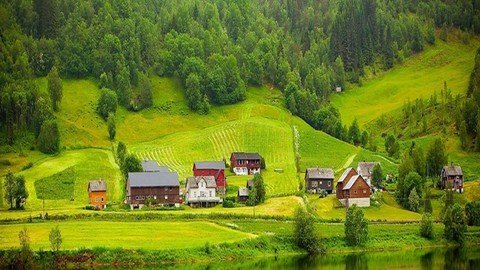Permaculture Land Conservation

Published 6/2023
MP4 | Video: h264, 1280x720 | Audio: AAC, 44.1 KHz
Language: English | Size: 3.70 GB | Duration: 2h 49m
Soil conservation, Water conservation techniques, Sustainable agriculture, Agroforestry ultimate guide etc.
What you'll learn
Soil conservation practices
Water conservation techniques
Permaculture techniques beyond farming
Agroforestry ultimate guide
Permaculture afforestation and reforestation
Sustainable agriculture
Wildlife management
Common practices of permaculture
Foundational ethics of permaculture
Requirements
No special requirements
Desire to learn more about the environment
Desire to seek knowledge about permaculture
Description
Permaculture, at it core, is sustainable agriculture. It also include twelve design principles that expand beyond farming and offer an ecological approach to modern living communities- for example, energy conservation and zero waste living. But the philosophy is ultimately rooted in better land management. Permaculture prioritizes biodiversity, environmental preservation, and soil regeneration while also cultivating crops for community consumption. The practice can improve soil health and sustain ample crop yields within the same plot indefinitely. This means that farmers observe and respond to their unique, local ecosystem by mimicking numerous strategies such as intercropping, agroforestry, and water management to grow essential foods and materials whiles improving land health. These techniques eliminate irrigation, pesticide application, and deforestation.Soil conservation is the practice of protecting and improving soil quality. It is a local, national, and global concern, soil conservation efforts are working hard with local communities across the globe to improve the health of the soil so there will be enough for generation. In fact poor soil greatly affect the productivity of the plants that are grown. Soil is the foundation of our food production. Let us all ensure that we practice effective farming strategy so that the land will be fertile for the generations yet unborn.
Overview
Section 1: Introduction
Lecture 1 Introduction
Lecture 2 What is permaculture
Lecture 3 What is conservation
Lecture 4 Foundational ethics of permaculture
Lecture 5 A need for better land management
Lecture 6 Permaculture as a solution
Lecture 7 Indigenous land practices and food sovereignty
Lecture 8 Ways to practice permaculture in our communities
Lecture 9 How does permaculture and conservation movement get along
Lecture 10 Controversial weeds
Lecture 11 Water conservation for permaculture garden
Lecture 12 Difference between permaculture and organic gardening
Lecture 13 Common permaculture practices
Section 2: Soil Conservation
Lecture 14 What is soil conservation
Lecture 15 Soil conservation practices
Lecture 16 Reducing the use of pesticides
Lecture 17 Soil organism
Lecture 18 Salinity management
Lecture 19 Benefits of soil conservation
Section 3: Permaculture Afforestation And Reforestation
Lecture 20 What is a forest
Lecture 21 The problem of deforestation
Lecture 22 The challenges of afforestation and reforestation
Lecture 23 Why planting trees alone is not enough
Lecture 24 Types of forest
Lecture 25 Reforestation and afforestation strategies
Lecture 26 Permaculture afforestation and reforestation
Lecture 27 Trophic rewilding techniques for afforestation and reforestation
Lecture 28 Agroforestry techniques
Section 4: Sustainable Agriculture
Lecture 29 Introduction to sustainable agriculture
Lecture 30 Key principle of sustainable agriculture
Lecture 31 Environmental factors
Lecture 32 Social factors
Lecture 33 Economic factors
Lecture 34 Challenges and debates
Section 5: Agroforestry Ultimate guide
Lecture 35 What is agroforestry
Lecture 36 Examples of common agroforestry practices
Lecture 37 What are the benefits of agroforestry
Lecture 38 The history of agroforestry
Lecture 39 The challenges of agroforestry
Section 6: Water Conservation Techniques
Lecture 40 Catch and store rain waters
Lecture 41 Swale used as a trench pit
Lecture 42 Containers
Lecture 43 Ponds
Lecture 44 Give water a complicated pathway
Lecture 45 Leaky sinks
Section 7: Permaculture Techniques Beyond Gardening
Lecture 46 Conserve resources
Lecture 47 Reuse materials
Lecture 48 Build interdependence
Lecture 49 Respond with creativity
Section 8: Wildlife Management
Lecture 50 Wildlife management
Section 9: Conclusion
Lecture 51 Permaculture questions
Agricultural agencies, farmers, conservationist, horticulturalist, agronomist, extension officers, directors, students, environmentalist, CEO, managers, policy makers, Agricultural ministries etc.
Screenshots
Homepage
without You and Your Support We Can’t Continue
Thanks for Buying Premium From My Links for Support
Click >>here & Visit My Blog Daily for More Udemy Tutorial. If You Need Update or Links Dead Don't Wait Just Pm Me or Leave Comment at This Post
Download from free file storage
Resolve the captcha to access the links!
Registered members don't get captcha ... just sayin
